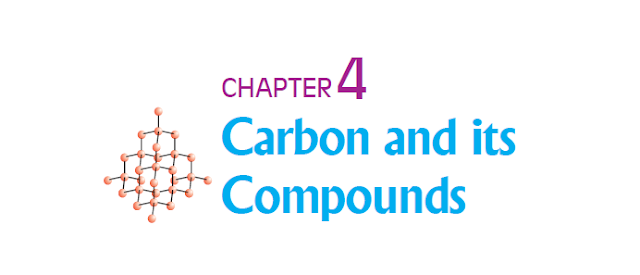CBSE | Class 10 | Chemistry | Solution
Chapter 4
Carbon and Its Compounds
Free NCERT Solutions for CBSE Class 10 chemistry are available here to download in PDF. Detailed and appropriate NCERT solutions will help to enhance your problem solving skills and get the desired results in your board examinations.
Page No 61
Questions:
1. What would be the electron dot structure of carbon dioxide which has
the formula CO2?
2. What would be the electron dot structure of a molecule of sulphur which
is made up of eight atoms of sulphur? (Hint – The eight atoms of sulphur
are joined together in the form of a ring.)
Solutions:
Page No 68
Questions:
1. How many structural isomers can you draw for pentane?
2. What are the two properties of carbon which lead to the huge number
of carbon compounds we see around us?
3. What will be the formula and electron dot structure of cyclopentane?
4. Draw the structures for the following compounds.
(i) Ethanoic acid (ii) Bromopentane*
(iii) Butanone (iv) Hexanal.
*Are structural isomers possible for bromopentane?
5. How would you name the following compounds?
Solutions:
Page No 76
Questions:
1. Would you be able to check if water is hard by using a detergent?
2. People use a variety of methods to wash clothes. Usually after adding
the soap, they ‘beat’ the clothes on a stone, or beat it with a paddle,
scrub with a brush or the mixture is agitated in a washing machine.
Why is agitation necessary to get clean clothes?
Solutions:
Textbook Exercise Questions
1. Ethane, with the molecular formula C2H6 has
(a) 6 covalent bonds.
(b) 7 covalent bonds.
(c) 8 covalent bonds.
(d) 9 covalent bonds.
2. Butanone is a four-carbon compound with the functional group
- (a) carboxylic acid.
- (b) aldehyde.
- (c) ketone.
- (d) alcohol.
3. While cooking, if the bottom of the vessel is getting blackened on the outside, it means that
(a) the food is not cooked completely.
(b) the fuel is not burning completely.
(c) the fuel is wet.
(d) the fuel is burning completely.
4. Explain the nature of the covalent bond using the bond formation in CH3Cl.
Solutions from Que 1 to 4:
5. Draw the electron dot structures for
(a) ethanoic acid.
(b) H2S.
(c) propanone.
(d) F2 .
Solutions of Que 5:
6. What is an homologous series? Explain with an example.
7. How can ethanol and ethanoic acid be differentiated on the basis of their physical and chemical properties?
Solutions from Que 7 to 7:
8. Why does micelle formation take place when soap is added to water? Will a micelle be formed in other solvents such as ethanol also?
9. Why are carbon and its compounds used as fuels for most applications?
Solutions from Que 8 to 9:
10. Explain the formation of scum when hard water is treated with soap.
11. What change will you observe if you test soap with litmus paper (red and blue)?
12. What is hydrogenation? What is its industrial application?
Solutions from Que 10 to 12:
13. Which of the following hydrocarbons undergo addition reactions:
C2H6, C3H8, C3H6, C2H2 and CH4.
14. Give a test that can be used to differentiate chemically between butter and cooking oil.
15. Explain the mechanism of the cleaning action of soaps.
Solutions from Que 13 to 15:
Note: To take pdf of solution of "Carbon and Its Compounds | CBSE | Class 10 | Chemistry | Chapter 4" send an email to boostyourconcept@gmail.com
Please subscribe to our YouTube channel, to visit channel Click Here
Thank-you,
Regards,
CONCEPT BOOSTER
Please subscribe to our YouTube channel, to visit channel Click Here
Thank-you,
Regards,
CONCEPT BOOSTER

















0 Comments